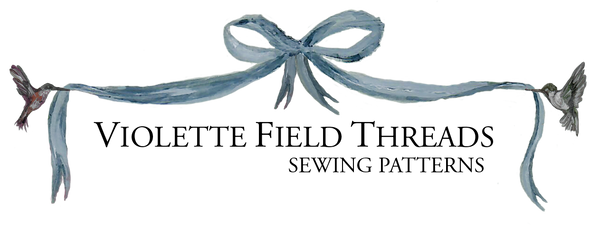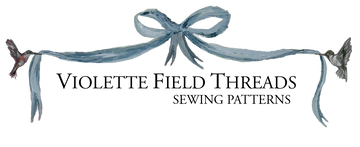2019 Tips & Tricks Recap {R-Z} + Giveaway!

Welcome back to the FINAL week of our tips and tricks recap from 2019! We will be reviewing tips from letters R-Z and then we will post a GIVEAWAY at the end... so lets get started!!

R is for a Rolled Hem! A rolled hem is a very narrow finish and can be made on a regular sewing machine or using a serger!

If you are sewing on a serger, you will only use three threads. The settings may vary from machine to machine, and on some you may need to remove the stitch finger. You may want to consult your manual for the correct settings for your specific machine. If you are sewing a rolled hem on your regular machine, there is a specific foot you can use (although they come in several different sizes). It features a groove on the back and a funnel on the front side.

This is where your fabric will roll up into and will go out through the back, running through the groove while the needle goes through it, creating a very small hem. Rolled hems are usually done on a regular machine when working with light-weight to medium-weight woven fabrics, but is most common with delicate fabrics. On either the regular machine or serger, it is a beautiful finish and can be especially helpful if you need to squeak out a hem that takes up less than a 1/2" of fabric.


S stands for Selvage! A selvage is the side of fabric where the finished edge stops the edges from fraying. The warp threads run parallel down the length of the fabric and the selvage is created when the weft threads are folded back on themselves at the end of each row as the fabric is woven. 
The selvage has become a beautiful part of the fabric design, and holds a wealth of information, such as the name of the fabric manufacturer and fabric make up. We have seen people use them on quilts and in other small projects. Another great use for them is as size tags on your projects. The color swatch circles usually have numbers printed inside of them and, since they don't fray, they work well for small size tags.


T is for tension! In the sewing worth this can easily bring on a headache if you do not understand it properly. If you are somewhat new to sewing, you may be asking what in the world it is? Tension is what keeps your bottom and top stitches in equal timing with one another. This ensures that the stitching on the front and back of your fabric looks the same, and that neither the upper nor the bobbin thread shows up on the opposite side of the fabric.

When the upper thread (what's going through your needle) is showing on the wrong side of the fabric, this means your tension is too low. In order to fix it, you raise the tension little by little, by rotating your tension knob to the right.

If the bottom thread from your bobbin is showing on the right side of the fabric, then it means that the tension disk is too tense. Slowly begin rotating your disk to the left, checking with each movement of the dial to see if the thread tension has evened back out when you're sewing.

If you have tried troubleshooting using these tips above, but are still having issues with your thread tension, your problem might be with your bobbin. The bobbin case also has some tension for the thread, and depending on what machine you use, you may be able to adjust it slightly by tightening or loosening a screw located on the side of your bobbin case. It is definitely a trial and error situation, but once you get the settings adjusted to the proper tension, you will notice right away if something is off again in the future!

U is for Universal Needles!! Whether you have the newest model sewing machine or a basic, entry level machine, the most important tool used is your needle!

Did you know? The sewing life of a needle is 8 hours! After that, the point will become worn and stitch quality may become compromised. We always keep some on-hand to change regularly. A good rule of thumb is to use a new needle at the start of every project.

Now, on to the Universal needle. The name says it all - universal - because it can be used on the majority of projects. We can use universal needles for both woven and knit fabrics because the point of a universal needle is both sharp and rounded, allowing the needle to have the characteristics of both sharp and ballpoint needles alike. They are not optimal for knits though, like true ballpoint stretch needles. Here is a great guide to knowing what needles you have and/or need!


V is for Vinyl! One of the latest and greatest things to enter the craft world over the last several years. With the Cricut, Silhouette, Brother Scan & Cut and other home vinyl cutting machines available, we've seen all sorts of great uses for this product.

We have seen so many creative ways that our members have incorporated vinyl into their at home sewing projects, to include details for princess costumes, wording for special occasion tops/dresses, and even adding size tags inside clothing with the vinyl! One of my personal favorites though, is how Ashley Cowan used vinyl to create the face for her blushing bunny!

You can use a vinyl machine to add so many personal touches to your sewing projects! The options truly are endless!


W is for the Walking Foot! The walking foot is a presser foot that allows even sewing over lots of layers or thicker fabric.

It grips the fabric on the top, while the feed dogs grip the bottom, and they work together to help the fabric to walk through when sewing. It is a very bulky and strange looking foot, but has a few different uses.

Many people use it to sew knits, but we don't think they are necessarily helpful on all machines. Some machines sew knits just fine without it, but there are people who have lots of success sewing knit with the aid of this foot, so it may be worth experimenting. It can also be very useful when sewing multiple layers, like on straps or binding. It will keep those ripples that can sometimes show up from happening because all layers of the fabric will be fed evenly through. Whatever you decide to use your walking foot for, it is a very handy foot to own!

X is for X-tra! We are getting close to the end of the alphabet, and finding "sewing" themed tips for each letter has been a lot of fun...but the letter "X" had us stumped! Not being able to come up with a term that started with the letter "X" we decided to get a little creative!! Letter "X" for our tips and tricks is going to stand for being a little "X-tra" = something we always encourage!! We provide the patterns, and what's great about them is all the room for creativity you have with them! We love it when we see designs that have gone the extra mile: put on that extra trim or those special buttons. Sometimes it's the extraordinary touches that brings an outfit from great to spectacular! So, don't be afraid to be a little "X-tra!" Make your garment unique to you and "X-tra" special!!

 Y is for a Yardage Chart! When you are out and about at a fabric store, having a handy yardage chart for easy access can make deciding on how much you need cut a simple task! Just print (or save a screen shot) of this cute little chart below and keep it for a quick reference!
Y is for a Yardage Chart! When you are out and about at a fabric store, having a handy yardage chart for easy access can make deciding on how much you need cut a simple task! Just print (or save a screen shot) of this cute little chart below and keep it for a quick reference!

And moving on to our FINAL letter of the alphabet - AND our giveaway as well.....

Z is for ZIPPERS!!! Zippers are something we are ALL familiar with using in our day to day lives, but did you know there are many different kinds of zippers? Depending on what project you are working on would decide which type of zipper you should purchase?!

Although there are many types of zippers, for times sake, we are going to cover the 3 most commonly used zippers!

The first type of zipper (shown above) is the Nylon Coil Zipper (also knows as an all-purpose zipper) and is the most common zipper option and can be used to make a variety of projects. Coil zippers are thin, lightweight zippers with small teeth. They are made of plastic with polyester sides and come in a variety of colors. The endless varieties of colors available make this zipper a great choice when making our patterns, since you can usually find a match for the fabric you’re working with. This lightweight zipper can bend and flow with the garment and doesn’t weigh down the material like a heavier type of zipper would.

The second type of zipper (shown above) is the Invisible zipper! Unlike the nylon coil zipper, the coil for an invisible zipper is located on the back of the zipper, which hides it from view. The only part of the zipper that is exposed is the tear drop pull at the top of the zipper. This zipper is also lightweight and has very fine teeth. An invisible zipper can be tricky to sew, and I recommend ironing the zipper open before pinning it to your garment. You can also use an invisible zipper foot which helps to create the best seam.

The third type of zipper is the metal and plastic molded zippers. Both molded plastic and metal zippers have teeth that have been molded at regular intervals on both sides of the zipper tape. Both of these zipper options are very sturdy and do well when using heavier material, so better to be used for jeans, bags or jackets versus lightweight dresses.

And there you have it - our A-Z Sewing Tips & Tricks Roundup!! We hope you enjoyed these helpful tips and tricks being posted in one handy location for future reference! And to end it with a bang, we would love to do a GIVEAWAY for one lucky reader to be able to choose ANY 3 of our patterns to download, FREE OF CHARGE!! All you have to do to enter is comment below with your 3 favorite tips we have shared (they can be from any of these 3 past blog posts from our A-Z roundup!) and we will choose one random winner to receive the patterns of their choice next week!
Edited to add: CONGRATULATIONS to our winner = Lindsay Gibson!!
We will be sending you an email so you can claim your prize!
HAPPY SEWING!!!


The needles, rolled hems and zippers were so helpful, but all of them were!
I liked S,T and U the best. I never knew a needle had so many parts that had names lol!
I for interfacing
H for Hong Kong didn’t know that one !
O for overlock Have a serger and contemplating getting a overlocker !
Thanks for being my favorite pattern maker and for all the X tras !!!
My 3 favorite tips are French seams, clear elastic, and rolled hem feet for your machine :)
They were all so great! The most helpful ones, because they are ones I’ve been intimidated to apply are knits, zippers, and rolled hens!
Leave a comment